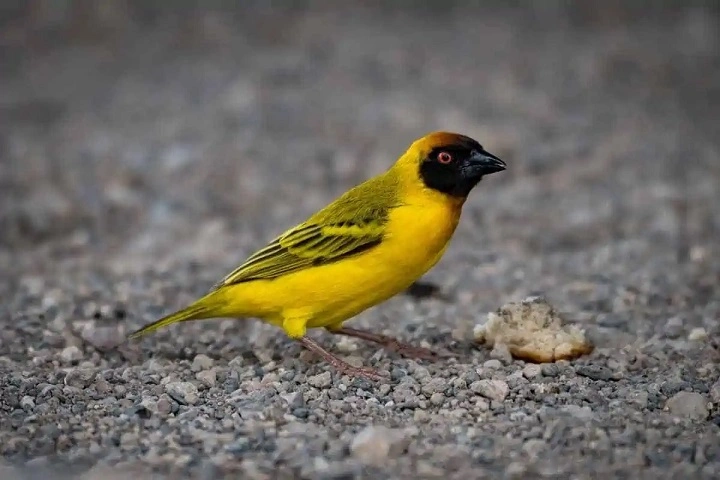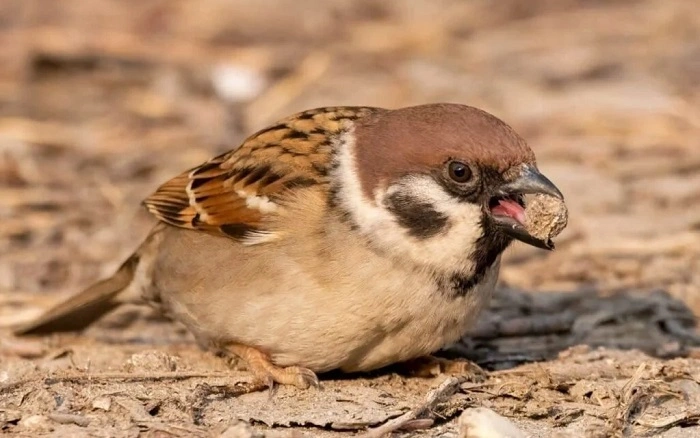It does sound strange initially. Birds consuming rocks? Pea-sized rocks, gravel, sand particles—it is almost like curiosity rather than hunger. But the fact is, rocks form a part of the life of most birds. Birds do not have teeth, like mammals. They are unable to chew food into mouthfuls before swallowing. Therefore, they use something else—grit, pebbles, and rocks—to grind food in their muscular gizzard.
This entry will explore the reasons why birds eat rocks, which of the birds use grit the most, what happens in their digestive system, what effect it has on their health, and what it implies regarding survival and adaptation. After reading it, the picture of a sparrow or chicken scratching at small rocks will no longer come across as peculiar—it will seem like nature’s subtle genius working.
Why Do Birds Eat Rocks?
No Teeth, Big Problem
Mammals rip up food into small, chewable pieces. Birds reverse the process. They swallow seeds, grains, fruits, insects, and even tough shells whole. The challenge is to mill it up so that the nutrients can be sucked out. Stones are used as nature’s tooth replacement.
The Job of Grit
When a bird eats pebbles, the pebbles travel to the gizzard—a hard sac in its digestive system. The gizzard clamps shut and grinds. The pebbles grind down food by abrading against it, grinding hard shells and seeds. Grinding is intense, almost a mortar and pestle inside the body.
More Than Just Grinding
Rocks also aid in digestion by breaking down food particles. They allow more nutrients to be extracted from seeds and grains. They make waste smaller as more energy is obtained from the same meal. Bottom line: rock eating is not normal. It is an adaptation.
What Type of Rocks Do Birds Eat?
Size Matters
Birds don’t swallow any old rock. They choose ones small enough to swallow but big enough to grind food. Pebbles, gravel, coarse sand—those are ideal.
Other Birds, Other Options
Small birds like finches or sparrows choose fine sand and little pebbles. Chickens and turkeys choose medium gravel. Big birds like ostriches or emus swallow bigger stones, even marbles.
Natural Selection
Birds are highly intelligent in their choice. They avoid pointed rocks that will penetrate their digestive tract. They choose smooth, rounded rocks.
The Rock Digestive Process
Step 1: Swallowing
The bird picks up a pebble in its beak and swallows it whole without grinding. It goes down the esophagus and into a small storage bag known as the crop.
Step 2: Crop Storage
The gizzard’s temporary storage feeds the crop. Rocks are stored here until food passes through them.
Step 3: Gizzard Magic
This is where the magic occurs. The gizzard’s mighty muscles compress, grinding food against rocks. Seeds crack. Shells blow apart. Even hard-shelled insects are destroyed.
Step 4: Replacement Cycle
Sands become smooth over time. Too smooth to be processed, birds are replenished by droppings and new ones are consumed. It is a process of ongoing replacement.
Do All Birds Eat Rocks?
Ground-Feeding Birds
Chickens, quails, turkeys, and pigeons greatly rely on grit. They consume seed-containing food, and thus grinding is imperative.
Waterfowl
Ducks, geese, and swans contain river bottom pebbles in their gizzards. Hard seeds and aquatic plants in their food have served as grinding aid.
Large Flightless Birds
Ostriches and emus are also famous for consuming large rocks. They consume hard plant material and small bones, all of which are pulverized with the help of grit.
Birds of Prey
Eagles and hawks do not actually need grit as they tear flesh to pieces with their beaks and sharp claws. But they do swallow small bones which do need the help of the gizzard.
Songbirds
Not every songbird needs grit, especially those eating soft fruits and insects. Most, however, ingest small sand for digestive purposes.
Rocks vs. Other Digestion Aids
Calcium-Rich Shells
Certain birds eat pieces of seashell or limestone, not just for grinding but as a source of calcium supplements—needed in egg-laying.
Charcoal and Clay
Wild amazon parrots have been known to eat clay. It cleans the poison of unripe fruits and seeds.
Human-Provided Grit
Backyard chicken owners are the primary supplier of grit. Granite grit, oyster shell grit, or flint stones are used.
Myths About Birds Eating Rocks
One of the most prevalent myths is that birds swallow pebbles by accident. Nope. Birds will spit out pebbles on purpose. It’s a habit. Another myth is that the pebbles stay inside the bird permanently. Nope. Pebbles are replaced every so often as they wear away. Some folks believe that all birds need pebbles. Not so. It happens that only seed-eating or heavy-grain diet birds need grit. Nectar feeders like hummingbirds don’t.
Case Studies: Species That Depend on Stones
- Chickens – Domestic chickens adapt very well with the supplement of grit. Without it, digestion will be poor and nutrient uptake will be hindered.
- Pigeons – Street pigeons always incorporate tiny pebbles of the roadside in their diet. That is the reason why they can survive on anything from seeds to trash.
- Ostriches – Ostriches swallow rocks two inches in size. Their gizzards are strong enough to break down plant fiber, bone, and even glass.
- Parrots in the Wild – Since parrots don’t need grit like chicken does, clay and tiny pieces perform the same function in digestion.
What Happens If Birds Don’t Eat Rocks?
Gritless, ineffectively digested by birds. Seeds are expelled without digestion. Inadequate nutrition ensues, along with weakness. Crop impaction may result from food obstruction without grinding aid. Egg-laying birds suffer from poor reproduction unless there are calcium materials present. Finally, rocks are what survival amounts to.
The Science Behind Grit
Muscular Strength
Thick, muscular gizzard wall. Muscles contract, forcing food against stones. Grinding pressure identical to mechanical mills.
Evolutionary Advantage
Millions of years ago, birds developed gizzards. Fossils record that dinosaurs used gastroliths, stomach stones, to crush plant food.
Energy Efficiency
Birds save energy with stones. They don’t need teeth and strong jaw muscles. Lightweight skulls enable flight.
Do Pet Birds Need Rocks?
Cage Birds
Parakeets, canaries, and finches-domesticated, may or may not utilize grit depending on diet. Pre-ground, well-balanced modern pelleted diets reduce the necessity.
Poultry at Home
Backyard chickens appreciate the grit provided. Granite powder mixes combined with oyster shell are sold for their use.
Prevention of Overuse
An excess of grit will cause blockage. Use restraint. Provide clean, size-formulated grit at all times.
Rocks in the Environment
When exhausted pebbles are brought to the surface by birds through regurgitation, they churn the soil. Minerals are circulated to the world. Deserts to marshes, learn birds. Where rock, pebble, and grit exist, it is a world implemented.
Human Observation: Its Worth
Farmers, bird-keepers, and nature watchers all observe the same thing. Grit is the equivalent of healthy birds. Flocks are not healthy without them. Such information improves poultry farming, conservation, and even pet-keeping.
Practical Tips: How to Help Birds with Grit
Provide a shallow dish of grit for backyard chickens. Crushed oyster shells can be used as a calcium supplement. Bird size has to be matched with size of grit. No sharp or pointed rocks. Replace grit periodically because birds will swap out old rocks with new ones.
FAQs: Do Birds Eat Rocks?
Why do birds eat rocks?
Birds swallow stones to help grind food in the gizzard because they have no teeth to chew with.
Do all birds eat stones?
No. Soft-fruit or nectar birds usually don’t. Seed-eaters and grain-eaters require grit.
Will stones harm birds?
Not if chosen carefully. Birds will naturally choose safe, smooth stones.
Does a pet bird require grit?
Pigeons and poultry do. Cage birds on pellets perhaps not.
How often do birds replace rocks?
Always. Inherited smoothed rocks, new pebbles are picked up.
Did dinosaurs also eat rocks?
Yes. Herbivorous dinosaurs swallowed gastroliths for digestive purposes, fossils have discovered.
What are the sizes of rocks swallowed by ostriches?
Large ones—two inches in diameter, to chew up their hard plant diet.
Closing Thoughts
Birds consuming rocks isn’t weird—it’s genius. Mother Nature discovered a work-around for the teeth issue. Instead of chomping, birds grind. Instead of jaws, they possess gizzards and grit. If you observe a pigeon scratching at rocks, or a hen foraging for pebbles, you are seeing survival. Little rocks, big purpose. It isn’t a curiosity. It’s survival.





